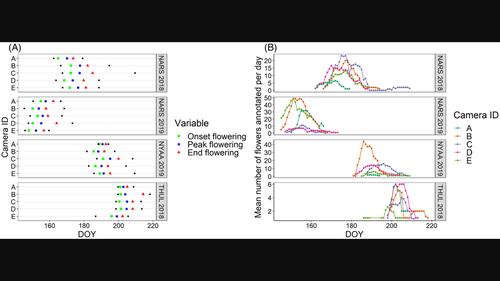当前位置:
X-MOL 学术
›
Remote Sens. Ecol. Conserv.
›
论文详情
Our official English website, www.x-mol.net, welcomes your
feedback! (Note: you will need to create a separate account there.)
Automatic flower detection and phenology monitoring using time-lapse cameras and deep learning
Remote Sensing in Ecology and Conservation ( IF 3.9 ) Pub Date : 2022-06-02 , DOI: 10.1002/rse2.275 Hjalte M. R. Mann 1, 2 , Alexandros Iosifidis 2 , Jane U. Jepsen 3 , Jeffrey M. Welker 4, 5, 6 , Maarten J. J. E. Loonen 7 , Toke T. Høye 1
Remote Sensing in Ecology and Conservation ( IF 3.9 ) Pub Date : 2022-06-02 , DOI: 10.1002/rse2.275 Hjalte M. R. Mann 1, 2 , Alexandros Iosifidis 2 , Jane U. Jepsen 3 , Jeffrey M. Welker 4, 5, 6 , Maarten J. J. E. Loonen 7 , Toke T. Høye 1
Affiliation

|
The advancement of spring is a widespread biological response to climate change observed across taxa and biomes. However, the species level responses to warming are complex and the underlying mechanisms are difficult to disentangle. This is partly due to a lack of data, which are typically collected by direct observations, and thus very time-consuming to obtain. Data deficiency is especially pronounced in the Arctic where the warming is particularly severe. We present a method for automated monitoring of flowering phenology of specific plant species at very high temporal resolution through full growing seasons and across geographical regions. The method consists of image-based monitoring of field plots using near-surface time-lapse cameras and subsequent automated detection and counting of flowers in the images using a convolutional neural network. We demonstrate the feasibility of collecting flower phenology data using automatic time-lapse cameras and show that the temporal resolution of the results surpasses what can be collected by traditional observation methods. We focus on two Arctic species, the mountain avens Dryas octopetala and Dryas integrifolia in 20 image series from four sites. Our flower detection model proved capable of detecting flowers of the two species with a remarkable precision of 0.918 (adjusted to 0.966) and a recall of 0.907. Thus, the method can automatically quantify the seasonal dynamics of flower abundance at fine scale and return reliable estimates of traditional phenological variables such as the timing of onset, peak, and end of flowering. We describe the system and compare manual and automatic extraction of flowering phenology data from the images. Our method can be directly applied on sites containing mountain avens using our trained model, or the model could be fine-tuned to other species. We discuss the potential of automatic image-based monitoring of flower phenology and how the method can be improved and expanded for future studies.
中文翻译:

使用延时相机和深度学习进行自动花卉检测和物候监测
春天的到来是对跨类群和生物群落观察到的气候变化的广泛生物反应。然而,物种层面对变暖的反应是复杂的,潜在的机制很难理清。这部分是由于缺乏数据,这些数据通常是通过直接观察收集的,因此获取起来非常耗时。数据不足在变暖特别严重的北极尤为明显。我们提出了一种通过整个生长季节和跨地理区域以非常高的时间分辨率自动监测特定植物物种开花物候的方法。该方法包括使用近地表延时摄像机对田间地块进行基于图像的监测,随后使用卷积神经网络自动检测和计算图像中的花朵。我们证明了使用自动延时相机收集花物候数据的可行性,并表明结果的时间分辨率超过了传统观察方法所能收集到的数据。我们专注于两种北极物种,mountain avensDryas octopetala和Dryas integrifolia来自四个站点的 20 个图像系列。我们的花检测模型被证明能够以 0.918(调整为 0.966)的惊人精度和 0.907 的召回率检测这两个物种的花。因此,该方法可以在精细尺度上自动量化花朵丰度的季节性动态,并返回对传统物候变量的可靠估计,例如开花开始、高峰和结束的时间。我们描述了该系统并比较了从图像中手动和自动提取开花物候数据的方法。我们的方法可以使用我们经过训练的模型直接应用于包含山地 avens 的站点,或者可以对该模型进行微调以适应其他物种。我们讨论了基于图像的花物候自动监测的潜力,以及如何改进和扩展该方法以用于未来的研究。
更新日期:2022-06-02
中文翻译:

使用延时相机和深度学习进行自动花卉检测和物候监测
春天的到来是对跨类群和生物群落观察到的气候变化的广泛生物反应。然而,物种层面对变暖的反应是复杂的,潜在的机制很难理清。这部分是由于缺乏数据,这些数据通常是通过直接观察收集的,因此获取起来非常耗时。数据不足在变暖特别严重的北极尤为明显。我们提出了一种通过整个生长季节和跨地理区域以非常高的时间分辨率自动监测特定植物物种开花物候的方法。该方法包括使用近地表延时摄像机对田间地块进行基于图像的监测,随后使用卷积神经网络自动检测和计算图像中的花朵。我们证明了使用自动延时相机收集花物候数据的可行性,并表明结果的时间分辨率超过了传统观察方法所能收集到的数据。我们专注于两种北极物种,mountain avensDryas octopetala和Dryas integrifolia来自四个站点的 20 个图像系列。我们的花检测模型被证明能够以 0.918(调整为 0.966)的惊人精度和 0.907 的召回率检测这两个物种的花。因此,该方法可以在精细尺度上自动量化花朵丰度的季节性动态,并返回对传统物候变量的可靠估计,例如开花开始、高峰和结束的时间。我们描述了该系统并比较了从图像中手动和自动提取开花物候数据的方法。我们的方法可以使用我们经过训练的模型直接应用于包含山地 avens 的站点,或者可以对该模型进行微调以适应其他物种。我们讨论了基于图像的花物候自动监测的潜力,以及如何改进和扩展该方法以用于未来的研究。











































 京公网安备 11010802027423号
京公网安备 11010802027423号